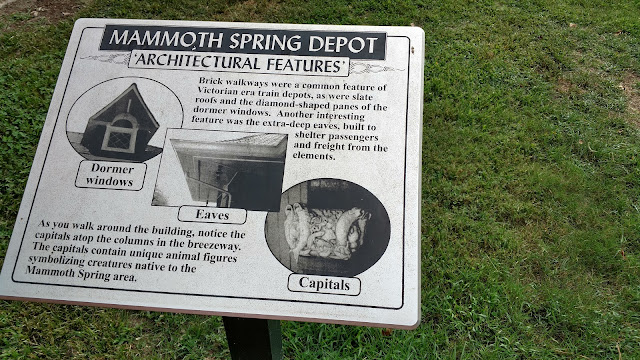This weekend was all about visiting with my brother. Mary Jane and I planned to arrive on Friday so we would have the whole weekend.....it has been way too long since I have seen my brother Tim. Saturday morning, Tim and his friend Cherie showed up at the Chipmunk Crossing RV Park where we were staying. We sat around and had a nice visit and I whipped up some tacos for lunch then they wanted to take us for some nearby sightseeing. My parents moved to Thayer Missouri when Tim was young so he more or less grew up in this neighborhood of Thayer MO and Mammoth Spring AR.
We drove the back roads over to Mammoth Spring. First stop was the Mammoth Spring National Fish Hatchery, a place I had never been. It is one of the oldest in the nation, established in 1903 and producing fish for the public waters.
There is a pretty waterfall right in front of the building which helps to aerate the pond with big fish swimming around in it.
Once inside, we found some information on the Spring itself. Mammoth Spring is the largest spring in Arkansas and one of the largest in the world. It averages an output of 347 cubic feet per second. It has been a National Landmark since 1972. Rainfall over a 100 mile radius seeps into the ground to underground passages and eventually finds it's way to the spring. The temperature of the spring is 58 degrees. There is a very high concentration of oxygen and nitrogen which combined with the cold temperature makes the spring itself very inhospitable to fish. Once the water goes over the dam into the Spring River releasing most of the nitrogen, it is a very healthy environment for fish.
The Ozark Mountains cover southern Missouri and northwest and north central Arkansas. They are considered a highly eroded ancient plateau that may have once been as high as the Himilayas. There are numerous springs and caverns in this area.
The hatchery was built here because of the high quality gravity flow of water and proximity to the railroad for transport of the fish. The hatchery produces 40,000 paddlefish and 2500 sturgeon each year. They also produce around 5000 mussels annually and 2 million Gulf Coast striped bass along with 400,000 walleye, 100,000 small mouth bass, and 100,000 largemouth bass and/or bluegill.
Natural scenery is also on display.
An Indian legend says that the son of a chief died while he was searching for water during a drought. As the chief was burying him, water sprang up from the grave hole and the chief believed it would flow forever. The town of Mammoth Spring can trace its roots back to 1820 when William Lindley claimed squatters rights to 40 acres surrounding the spring.
In 1929, George D. Hay visited the springs and was invited to an Ozark musical and dance performance. He later credited that visit as inspiration for starting the Grand Ole Opry.
The fish were originally transported to new locations in fish cars on the railroad.
They were transported in containers like this.
The Hellbender is a unique and environmentally sensitive species only found in the Ozarks. They are unique salamanders whose population is diminishing. Scientists are currently studying the reason for the lack of reproduction of the last decade.
Mammoth Spring's nine million gallons of water hourly forms a 10 acre lake that flows over a dam into the Spring River. There is a lovely park surrounding the spring.
Also located in the park is the Mammoth Spring Depot. My niece Savannah met us at the depot and joined us for dinner at a very popular Mammoth landmark restaurant.
It is a Victorian style depot with brick walkways and slate roofs.
The Mammoth Spring Depot was built in 1885 for the Kansas City, Ft. Scott & Memphis Railroad and was a social hub for the community.
Notice the fancy cornices on the top of the columns. There is a museum inside the depot but it was already closed when we arrived. The outside was just as interesting.
The Frisco Caboose was an RV for the railroad brakeman and conductor. They could fix meals, sleep, and set the inside up to their liking. They also carried repair parts here.
Mary Jane is checking out the schedule of arrivals and departures.
 |
This is part of the dam across the edge of the spring.
The spring is surrounded by a lovely park with picnic tables.
Inside the building housing the generator on the edge of the dam. It was taken out of service in 1972 because it was no longer economical to operate and was donated to the Arkansas State Parks the same year.
The water thunders over the dam into the river.
I don't know what this little building was originally used for but Cherie said the grate was put over the door some time ago to keep teenagers from using it.
It was an interesting visit to the park...too bad they don't have a campground here but it is only day-use. As I said, we headed to Fred's Fish House in Mammoth for dinner. Just be aware that they are very popular and portions are huge.


































No comments:
Post a Comment
Thanks for commenting.